
In botany, a spadix is a type of inflorescence having small flowers borne on a fleshy stem. Spadices are typical of the family Araceae, the arums or aroids. The spadix is typically surrounded by a leaf-like curved bract known as a spathe. For example, the "flower" of the well known Anthurium spp. is a typical spadix with a large colorful spathe.
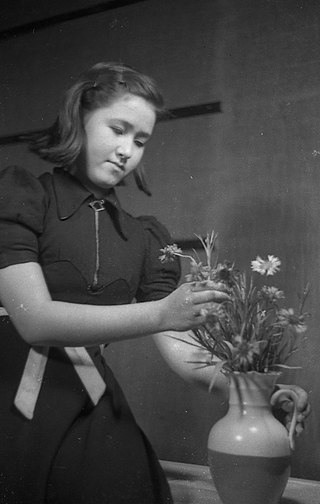
Floral design or flower arrangement is the art of using plant material and flowers to create an eye-catching and balanced composition or display. Evidence of refined floral design is found as far back as the culture of ancient Egypt. Floral designs, called arrangements, incorporate the five elements and seven principles of floral design.

Rosa carolina, commonly known as the Carolina rose, pasture rose, or prairie rose, is a perennial shrub in the rose family native to eastern North America. It can be found in nearly all US states and Canadian provinces east of the Great Plains. It is common throughout its range and can be found in a wide variety of open habitats, from thickets and open woods to roadsides and along railroads.

Pectocarya is a plant genus of about 15 species in the family Boraginaceae. Plants in this genus are known generally as combseeds. They are small annual plants which bear tiny white flowers no more than 3 millimeters in diameter. Their fruits are nutlets which often have small projections that look like the teeth of a comb, hence their common name. The nutlets usually come in clusters of four. These plants are found mainly in western North America.

Chasmanthe floribunda is a species of flowering plant in the iris family which is known by the common name African flag. This plant is endemic to Cape Province in South Africa, but it has been introduced to other areas of similar climate, and is considered to be naturalized in California, Algeria, Australia, Argentina, and St. Helena.

Eriogonum nidularium is a species of wild buckwheat known by the common name birdnest buckwheat. It is native to the sandy flats and desert dry washes of the Mojave Desert and Great Basin in the western United States, where it is common and abundant. This is a distinctive annual herb producing a thin, multibranched stem which curves in on itself to form a rounded, tangled mass.
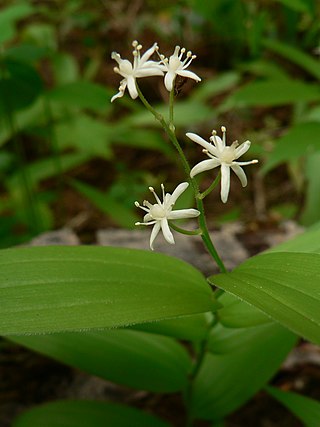
Maianthemum stellatum is a species of flowering plant, native across North America. It has been found in northern Mexico, every Canadian province and territory except Nunavut, and every US state except Hawaii and the states of the Southeast. It has little white buds in the spring, followed by delicate starry flowers, then green-and-black striped berries, and finally deep red berries in the fall.
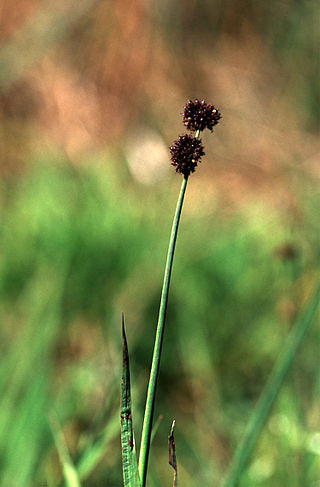
Juncus ensifolius is a species of rush known by the common names swordleaf rush, sword-leaved rush, and three-stamened rush. It is native to much of western North America from Alaska to central Mexico, and into eastern Canada. It is present in Japan and far eastern Russia, and it has been introduced to many other regions of the world, including Europe, New Zealand, Hawaii, and Australia. It is a plant of wet areas in many types of habitat. This is a rhizomatous perennial herb forming clumps of stems 20 to 60 centimeters tall. The flat but curving leaves are mostly located at the base of the stems and are variable in length. The inflorescence is an array of many rounded clusters of many flowers each. Each flower has a number of dark brown to black tepals a few millimeters long and usually three small stamens enclosed between them. The fruit is an oblong capsule with a small beak on the tip.
This glossary of botanical terms is a list of definitions of terms and concepts relevant to botany and plants in general. Terms of plant morphology are included here as well as at the more specific Glossary of plant morphology and Glossary of leaf morphology. For other related terms, see Glossary of phytopathology, Glossary of lichen terms, and List of Latin and Greek words commonly used in systematic names.
Juncus kelloggii is a species of rush known by the common name Kellogg's dwarf rush. It is native to western North America from British Columbia to California, where it grows in low, wet spots in meadows and other grassy areas, for example, vernal pools.
Pectocarya heterocarpa is a species of flowering plant in the borage family known by the common names chuckwalla combseed and mixed-nut pectocarya. It is native to the southwestern United States and northern Mexico, where it grows in desert, mountain and plateau habitat, in scrub, woodland, and open areas. This is an annual herb producing a slender, rough-haired stem prostrate or upright to a maximum length of about 25 centimeters. The small, pointed linear leaves are alternately arranged, widely spaced along the stem. The inflorescence is a series of flowers, each on a curved pedicel. The flower has small green sepals and tiny white petals. The fruit is an array of four nutlets each lined with comblike prickles.

Pectocarya penicillata is a species of flowering plant in the borage family known by the common names sleeping combseed, shortleaf combseed, winged combseed and northern pectocarya. It is native to much of western North America from British Columbia to Wyoming to Baja California, where it grows in many types of habitat, including disturbed areas such as roadsides. This is an annual herb producing a slender, rough-haired stem, mostly decumbent in form, to a maximum length of about 25 centimeters. The small, pointed linear leaves are alternately arranged, widely spaced along the stem. The inflorescence is a series of flowers, each on a curved pedicel. The flower has small green sepals and tiny white petals. The fruit is an array of four nutlets each lined with comblike prickles.
Pectocarya peninsularis is a species of flowering plant in the borage family known by the common names Baja pectocarya and peninsular pectocarya. It is native to the Sonoran Desert of California and Baja California, where it grows in open desert habitat, including disturbed areas. This is an annual herb producing a slender, rough-haired stem, decumbent or upright form to a maximum length of about 24 centimeters. The small, pointed linear leaves are alternately arranged, widely spaced along the stem. The inflorescence is a series of flowers, each on a curved pedicel. The flower has small green sepals and tiny white petals. The fruit is an array of four nutlets each lined with comblike prickles, those higher on the plant arranged in pairs and the lower ones unpaired.

Pectocarya pusilla is a species of flowering plant in the borage family known by the common names little combseed and little pectocarya. It is native to the west coast of the United States from Washington to central California, where it grows in several habitat types, including disturbed areas such as roadsides. This is an annual herb producing a slender, rough-haired stem, generally upright to erect in form to a maximum height of about 38 centimeters. The small, pointed linear leaves are alternately arranged higher on the stem, and those lower on the stem are oppositely arranged and fused at the bases. The inflorescence is a series of flowers, each on a curved pedicel. The flower has small green sepals with short hooked hairs and a rounded white corolla. The fruit is an array of four flattened nutlets with fringes of comblike hairs.

Pectocarya recurvata is a species of flowering plant in the borage family known by the common names curvenut combseed and arched-nut pectocarya. It is native to the southwestern United States and northwestern Mexico, where it grows in many types of desert habitat. It is an annual herb producing a slender, rough-haired stem, generally upright to erect in form to a maximum height of about 21 centimeters. The small, pointed linear leaves alternately arranged along the stem. The inflorescence is a series of flowers, each on a curved pedicel. The flower has small green sepals and a rounded white corolla. The fruits, borne in groups of four, are curved nutlets fringed with flat teeth, each measuring 2.5 to 4 millimeters long.
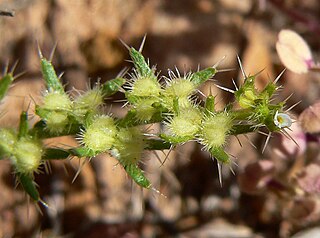
Pectocarya setosa, known by the common names moth combseed and round-nut pectocarya, is a species of flowering plant in the borage family.
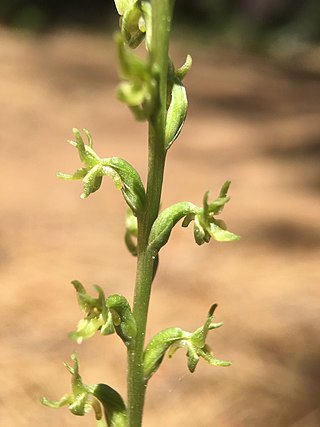
Platanthera colemanii is a rare species of orchid known by the common names Coleman's piperia and Coleman's rein orchid. It is endemic to California, where it is known from scattered occurrences along the Sierra Nevada and one disjunct location in Colusa County, California. It grows in coniferous forests and chaparral in deep sandy substrates. It was differentiated from the very similar Platanthera unalascensis in 1993.

Plagiobothrys fulvus is a species of flowering plant in the borage family known by the common names field popcornflower or fulvous popcornflower. It is native to California and Oregon in the United States, as well as Chile.
Iris curvifolia is a plant species in the genus Iris, it is also in the subgenus of Iris, and in the Psammiris section. It is a rhizomatous perennial, from China. It has sickle-shaped long leaves, short stem and yellow or bright yellow flowers. It is cultivated as an ornamental plant in temperate regions.
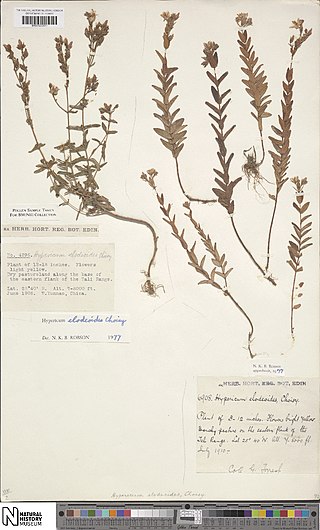
Hypericum elodeoides, commonly called the Himalayan St. John's Wort, is a species of flowering plant of the St. John's wort family (Hypericaceae).















